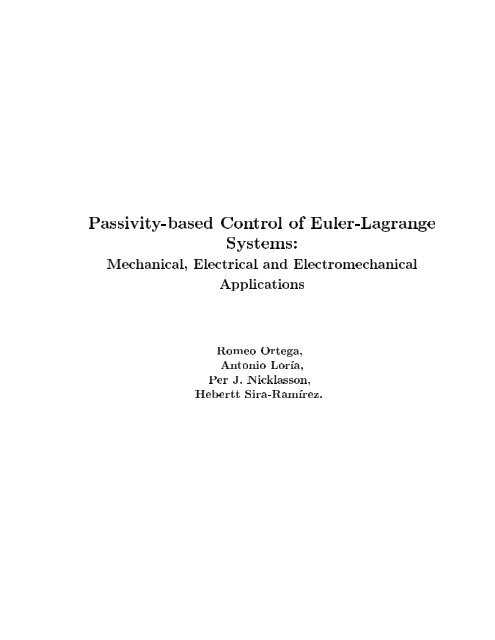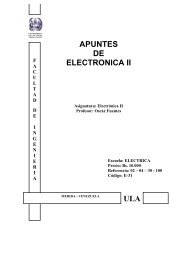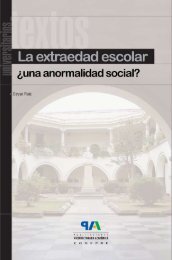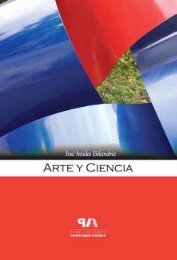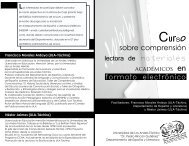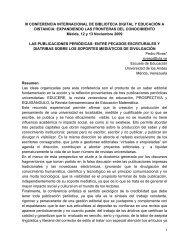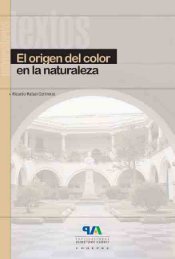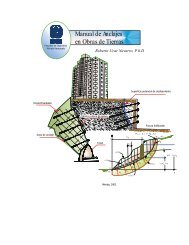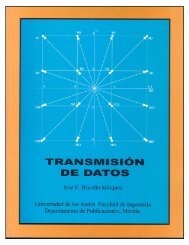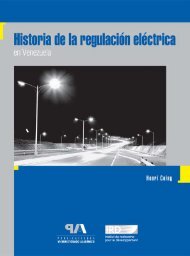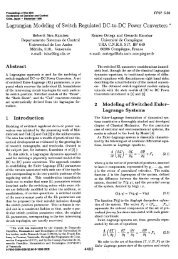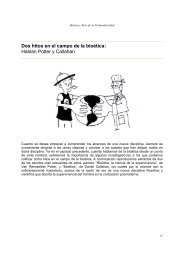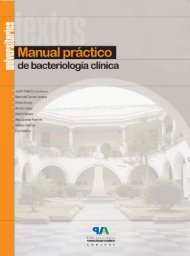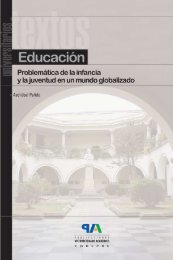Passivity-based Control of Euler-Lagrange Systems:
Passivity-based Control of Euler-Lagrange Systems:
Passivity-based Control of Euler-Lagrange Systems:
You also want an ePaper? Increase the reach of your titles
YUMPU automatically turns print PDFs into web optimized ePapers that Google loves.
<strong>Passivity</strong>-<strong>based</strong> <strong>Control</strong> <strong>of</strong> <strong>Euler</strong>-<strong>Lagrange</strong><br />
<strong>Systems</strong>:<br />
Mechanical, Electrical and Electromechanical<br />
Applications<br />
Romeo Ortega,<br />
Antonio Lora,<br />
Per J. Nicklasson,<br />
Hebertt Sira-Ramrez.
To Amparo with all my love,<br />
Romeo.<br />
To Lena with r =1; sin,<br />
to Mari my sister with my deepest admiration,<br />
To~no.<br />
To my parents,<br />
Per Johan.<br />
To Jose Humberto Ocariz E. with respect and aection,<br />
to Mara Elena and Mara Gabriela with all my love,<br />
Hebertt.
Preface<br />
By its own denition the nal purpose <strong>of</strong> control is to control something. In fact,<br />
the foundational developments <strong>of</strong> Huygens, Maxwell, Routh, Minorsky, Nyquist and<br />
Black (to name a few) were motivated by real{world applications. In the hands <strong>of</strong><br />
mathematicians such as Wiener, Bellman, Lefschetz, Kalman and Pontryagin (again,<br />
to name just a few) control theory developed in the 1950s and 1960s as a branch <strong>of</strong>applied<br />
mathematics, independent <strong>of</strong> its potential application to engineering problems.<br />
Some tenuous arguments were typically invoked to provide some practical motivation<br />
to the research on this so{called mathematical control theory. For instance, the<br />
study <strong>of</strong> the triple (A B C) was rationalized as the study <strong>of</strong> the linearization <strong>of</strong> an<br />
arbitrary nonlinear system {an argument that had a grain <strong>of</strong> truth. By the end <strong>of</strong><br />
the 1980s a fairly complete body <strong>of</strong> knowledge for general linear systems {including<br />
powerful techniques <strong>of</strong> controller synthesis{ had been completed. Some spectacular<br />
applications <strong>of</strong> this theory to practical situations that tted the linear systems<br />
paradigm were reported.<br />
The attempt to mimic the developments <strong>of</strong> linear systems theory in the general<br />
nonlinear case enticed many researchers. Extensions to a fairly general class <strong>of</strong> nonlinear<br />
systems <strong>of</strong> the basic concepts <strong>of</strong> controllability, observability, and realizability<br />
were crowned with great success. The controller synthesis problem proved to be,<br />
however, much more elusive. Despite some signicant progress, to date, general techniques<br />
for stabilization <strong>of</strong> nonlinear systems are available only for special classes <strong>of</strong><br />
nonlinear systems. This is, <strong>of</strong> course, due to the daunting complexity <strong>of</strong> the behaviour<br />
<strong>of</strong> nonlinear dynamic systems which puts a serious question mark on the interest <strong>of</strong><br />
aiming at a monolithic synthesis theory. On the other hand, new technological developments<br />
had created engineering problems where certain well{dened nonlinear<br />
eects had to be taken into account. Unfortunately, the theory developed for general<br />
nonlinear systems could not successfully deal with them, basically because the<br />
\admissible structures" were determined by analytical considerations, which do not<br />
necessarily match the physical constraints. It became apparent that to solve these<br />
new problems, the \nd an application for my theory" approach had to be abandoned,<br />
and anewtheory tailored for the application had to be worked out.<br />
The material reported in this book is an attempt in this direction. Namely, we<br />
start from a well{dened class <strong>of</strong> systems to be controlled and try to develop a theory<br />
vii
viii<br />
Preface<br />
best suited for them. As the title suggests, the class we consider covers avery broad<br />
spectrum (<strong>Euler</strong>{<strong>Lagrange</strong> systems with mechanical, electrical and electromechanical<br />
applications) however, detailed analysis is presented only for robots, AC machines and<br />
power converters. We have found that this set <strong>of</strong> applications is suciently general<br />
|it has at least kept us busy for the last 10 years!<br />
Dierent considerations and techniques are used to solve the various problems<br />
however, in all cases we strongly rely on the information provided by the variational<br />
modeling and, in particular, concentrate our attention on the energy and dissipation<br />
functions that dene the dynamics <strong>of</strong> the system. A second unifying thread to all<br />
the applications is the fundamental concept <strong>of</strong> passivity. Finally, a recurrent theme<br />
throughout our work is the notion <strong>of</strong> interconnection that appears, either in the form<br />
<strong>of</strong> a feedback decomposition instrumental for the developments, or as a framework<br />
for focusing on the relevant parts <strong>of</strong>amodel.<br />
An important feature <strong>of</strong> the proposed controller design approach is that it is<br />
<strong>based</strong> on the input{output property <strong>of</strong> passivity, hence it will typically not require<br />
the measurement <strong>of</strong> the full state to achieve the control objectives. Consequently,<br />
throughout the book we give particular emphasis to (more realistic, but far more<br />
challenging) output{feedback strategies.<br />
The book is organized in the following way. In Chapter 1 we present rst a<br />
brief introduction that explains the background <strong>of</strong> the book and elaborates upon<br />
its three keywords: <strong>Euler</strong>{<strong>Lagrange</strong> (EL) systems, passivity and applications. The<br />
notion <strong>of</strong> passivity{<strong>based</strong> control (PBC) is explained in detail also in this chapter,<br />
underscoring its conceptual advantages. The main background material pertaining<br />
to EL systems is introduced in Chapter 2. In particular we mathematically describe<br />
the class <strong>of</strong> systems that we study throughout the book, exhibit some fundamental<br />
input{output and Lyapunov stability properties, as well as some basic features <strong>of</strong><br />
their interconnection. We also give in this section the models <strong>of</strong> some examples <strong>of</strong><br />
physical systems that will be considered in the book.<br />
The remaining <strong>of</strong> the book is divided in three parts devoted to mechanical, electrical<br />
and electromechanical systems, respectively. The rst part addresses a class <strong>of</strong><br />
mechanical systems, <strong>of</strong> which a prototypical example are the robot manipulators, but<br />
it is not restricted to them. For instance, we consider also applications to simple models<br />
<strong>of</strong> marine vessels and rotational translational actuators. The results concerning<br />
mechanical systems are organized into set point regulation (Chapter 3), trajectory<br />
tracking (Chapter 4) and adaptive disturbance attenuation, with application to friction<br />
compensation (Chapter 5). The theoretical results are illustrated with realistic<br />
simulation results. In this part, as well as in other sections <strong>of</strong> the book, we carry out<br />
comparative studies <strong>of</strong> the performance obtained by PBC with those achievable with<br />
other schemes. In particular, for robots with exible joints, we compare in Chapter<br />
4 PBC with schemes <strong>based</strong> on backstepping and cascaded systems.<br />
The second part <strong>of</strong> the book is dedicated to electrical systems, in particular DC-
Preface<br />
ix<br />
DC power converters. In Chapter 6 the EL model is derived and the control relevant<br />
properties are presented. We present both, a switched model that describes the exact<br />
behaviour <strong>of</strong> the system with a switching input, and an approximate model for the<br />
pulse width modulator controlled converters. While in the rst model we have to<br />
deal with a hybrid system (with inputs 0 or 1), in the latter model, which isvalid for<br />
suciently high sampling frequencies, the control input is the duty ratio which is a<br />
continuous function ranging in the interval [0 1]. Besides the standard EL modeling,<br />
we also present a rather novel, and apparently more natural, Hamiltonian model that<br />
follows as a particular case <strong>of</strong> the extended Hamiltonian models proposed by Maschke<br />
and van der Schaft.<br />
Chapter 7 is devoted to control <strong>of</strong> DC-DC power converters. We present, <strong>of</strong><br />
course, PBC for the average models. To deal with hybrid models we also introduce<br />
the concept <strong>of</strong> PBC with sliding modes. We show that combining this two strategies<br />
we can reduce the energy consumption, awell{known important drawback <strong>of</strong> sliding<br />
mode control. Adaptive versions <strong>of</strong> these schemes, that estimate on{line the load<br />
resistance are also derived. An exhaustive experimental study, where various linear<br />
and nonlinear schemes are compared, is also presented.<br />
In the third part <strong>of</strong> the book we consider electromechanical systems. To handle<br />
this more challenging problem we introduce a feedback decomposition <strong>of</strong> the system<br />
into passive subsystems. This decomposition naturally suggests a nested{loop<br />
controller structure, whose basic idea is presented in a motivating levitated system<br />
example in Chapter 8. This simple example helps us also to clearly exhibit the connections<br />
between PBC, backstepping and feedback linearization. In Chapters 9{11<br />
we carry out a detailed study <strong>of</strong> nonlinear control <strong>of</strong> AC motors. The torque tracking<br />
problem is rst solved for the generalized machine model in Chapter 9. As an o{<br />
spin <strong>of</strong> our analysis we obtain a systems invertibility interpretation <strong>of</strong> the well-known<br />
condition <strong>of</strong> Blondel{Park transformability <strong>of</strong>themachine.<br />
The next two chapters, 10 and 11, are devoted to voltage{fed and current{fed<br />
induction machines, respectively. For the voltage{fed case we present, besides the<br />
nested{loop scheme, a PBC with total energy shaping. Connections with the industry<br />
standard eld oriented control and feedback linearization are thoroughly discussed.<br />
These connections are further explored for current{fed machines in Chapter 11. First,<br />
we establish the fundamental result that, for this class <strong>of</strong> machines, PBC exactly reduces<br />
to eld oriented control. Then, we prove theoretically and experimentally that<br />
PBC outperforms feedback linearization control. The robustness <strong>of</strong> PBC, as well as<br />
some simple tuning rules are also given. Finally, motivated by practical considerations,<br />
a globally stable discrete{time version <strong>of</strong> PBC is derived. Both chapters contain<br />
extensive experimental evidence.<br />
At last, in Chapter 12 we study the problem <strong>of</strong> electromechanical systems with<br />
nonlinear mechanical dynamics. The motivating example for this study is the control<br />
<strong>of</strong> robots with AC drives, for which we give a complete theoretical answer. The
x<br />
Preface<br />
chapter clearly illustrates how PBC, as applied to <strong>Euler</strong>{<strong>Lagrange</strong> models, yields a<br />
modular design which eectively exploits the features <strong>of</strong> the interconnections. In a<br />
simulation study we compare our PBC with a backstepping design showing, once<br />
again, the superiority <strong>of</strong>PBC.<br />
Background material on passivity, variational modeling and vector calculus are<br />
included in Appendices A, B and C, respectively.<br />
The book is primarily aimed at graduate students and researchers in control theory<br />
who are interested in engineering applications. It contains, however, new theoretical<br />
results whose interest goes beyond the specic applications, therefore it might be useful<br />
also to more theoretically oriented readers. The book is written with the conviction<br />
that to deal with modern engineering applications, control has to reevaluate its role<br />
as a component <strong>of</strong> an interdisciplinary endeavor. A lot <strong>of</strong> emphasis is consequently<br />
given to modeling aspects, analysis <strong>of</strong> current engineering practice and experimental<br />
work. For these reasons it may be also <strong>of</strong> interest for students and researchers, as<br />
well as practitioning engineers, involved in more practical aspects <strong>of</strong> robotics, power<br />
electronics and motor control. For this audience the book may provide a source to<br />
enhance their theoretical understanding <strong>of</strong> some well{known concepts and to establish<br />
bridges with modern control theoretic concepts.<br />
We have adopted the format <strong>of</strong> theorem{pro<strong>of</strong>{remark, which may give the erroneous<br />
impression that it is a \theoretical" book, this is done only for ease <strong>of</strong> presentation.<br />
Although most <strong>of</strong> the results in this book are new, they are presented at<br />
alevel accessible to audiences with a standard undergraduate background in control<br />
theory and a basic understanding <strong>of</strong> nonlinear systems theory. In order to favour<br />
the \readability" <strong>of</strong> our book we have moved some <strong>of</strong> the most \technical" pro<strong>of</strong>s to<br />
Appendix D.<br />
The material contained in the book summarizes the experience <strong>of</strong> the authors on<br />
control engineering applications over the last 10 years. It builds upon the PhD theses<br />
<strong>of</strong> the second and fourth author as well as collaborative research among all <strong>of</strong> us, and<br />
with several other researchers. Numerous colleagues and collaborators contributed<br />
directly and indirectly, andin various ways to this book.<br />
The rst author is particularly indebted to his former PhD students: G. Espinosa<br />
and R. Kelly triggered his interest in the areas <strong>of</strong> electrical machines and robotics,<br />
respectively, we have since kept an intensive and very productive research collaboration<br />
G. Escobar, K. Kim and D. Taoutaou carried out some <strong>of</strong> the experimental<br />
work on converters and electrical machines. He has also enjoyed a long scientic collaboration<br />
with L. Praly who always provided insightful remarks and motivation to<br />
his work. Many useful scientic exchanges have been carried out over the years with<br />
H. Nijmeijer, M. Spong and A. J. van der Schaft, while Henk and Arjan motivated<br />
him to improve his theoretical background, Mark always found the threshold necessary<br />
to make a robot turn. He would like to thank all his co{authors from whom he<br />
learned the importance <strong>of</strong> collaborative work. Finally, he wants to express his deep
xi<br />
gratitude to the french CNRS, which provides his researchers with working conditions<br />
unparalleled by any other institution in the world.<br />
The second author wishes to acknowledge specially the collaboration with his<br />
former undergraduate-school teacher R. Kelly who earlier introduced him to robot<br />
control and Lyapunov theory. The enthusiasm <strong>of</strong> Rafael on these topics increased the<br />
motivation <strong>of</strong> the second author to pursue a doctoral degree in the eld. During his<br />
doctoral research periodhewas also enriched with the advice and collaboration <strong>of</strong> H.<br />
Nijmeijer and L. Praly. The author wishes to express as well his deepest gratitude<br />
to his ancee and collaborator E. Panteley for her fundamental moral support in this<br />
project and for helping with the gures <strong>of</strong> Chapter 6. Last but not least, the work <strong>of</strong><br />
the second author has been sponsored by the institutions he has been aliated to in<br />
the past 5 years, in chronological order: CONACyT, Mexico University <strong>of</strong> Twente,<br />
The Netherlands University <strong>of</strong> Trondheim, Norway and University <strong>of</strong> California at<br />
Santa Barbara, USA.<br />
The third author wants to thank Research Director Peter Singstad, SINTEF Electronics<br />
and Cybernetics, Automatic <strong>Control</strong>, for supporting parts <strong>of</strong> this project -<br />
nancially.<br />
The fourth author is indebted to his colleagues and students <strong>of</strong> the <strong>Control</strong> <strong>Systems</strong><br />
Department <strong>of</strong> the Universidad de Los Andes (ULA) in Merida (Venezuela) for<br />
the continuous support over the years in many academic endeavors. Special thanks<br />
and recognition are due to his former student, Dr. Orestes Llanes-Santiago, for his<br />
creative enthusiasm and hard work in the area <strong>of</strong> switched power converters. Visits to<br />
R. Ortega, since 1995, have been generously funded by the Programme de Cooperation<br />
Postgradue (PCP), by the National Council for Scientic Research <strong>of</strong> Venezuela<br />
(CONICIT), as well as by the Centre National de la Recherche Scientique (CNRS)<br />
<strong>of</strong> France. Thanks are due to Pr<strong>of</strong>essor Marisol Delgado, <strong>of</strong> the Universidad Simon<br />
Bolvar, who has acted as a highly ecient PCP Coordinator in Venezuela. Over<br />
the years, the author has beneted from countless motivational discussions with his<br />
friend Pr<strong>of</strong>essor Michel Fliess <strong>of</strong> the Laboratoire des Signaux et Systemes (CNRS),<br />
France. His experience and vision has been decisively helpful in many <strong>of</strong> the author's<br />
research undertakings.<br />
R. Ortega, A. Lora, P. J. Nicklasson, H. Sira-Ramrez,<br />
May 1998.
xii
Contents<br />
Notation<br />
xxxi<br />
1 Introduction 1<br />
1 From control engineering to mathematical control theory and back . . 1<br />
2 A route towards applications . . . . . . . . . . . . . . . . . . . . . . . 3<br />
3 Why <strong>Euler</strong>{<strong>Lagrange</strong> systems? . . . . . . . . . . . . . . . . . . . . . . 4<br />
4 On the role <strong>of</strong> interconnection . . . . . . . . . . . . . . . . . . . . . . 7<br />
5 Why passivity? . . . . . . . . . . . . . . . . . . . . . . . . . . . . . . 8<br />
6 What is passivity{<strong>based</strong> control? . . . . . . . . . . . . . . . . . . . . 10<br />
7 Some historical remarks . . . . . . . . . . . . . . . . . . . . . . . . . 12<br />
7.1 <strong>Euler</strong>{<strong>Lagrange</strong> systems and nonlinear dynamics . . . . . . . . 12<br />
7.2 <strong>Passivity</strong> and feedback stabilization . . . . . . . . . . . . . . . 12<br />
2 <strong>Euler</strong>-<strong>Lagrange</strong> systems 15<br />
1 The <strong>Euler</strong>{<strong>Lagrange</strong> equations . . . . . . . . . . . . . . . . . . . . . . 16<br />
2 Input{output properties . . . . . . . . . . . . . . . . . . . . . . . . . 19<br />
2.1 <strong>Passivity</strong> <strong>of</strong> EL systems . . . . . . . . . . . . . . . . . . . . . 20<br />
2.2 <strong>Passivity</strong> <strong>of</strong> the error dynamics . . . . . . . . . . . . . . . . . 22<br />
2.3 Other properties and assumptions . . . . . . . . . . . . . . . . 24<br />
2.4 Passive subsystems decomposition . . . . . . . . . . . . . . . . 25<br />
2.5 An EL structure-preserving interconnection . . . . . . . . . . 26<br />
3 Lyapunov stability properties . . . . . . . . . . . . . . . . . . . . . . 27<br />
3.1 Fully-damped systems . . . . . . . . . . . . . . . . . . . . . . 27<br />
3.2 Underdamped systems . . . . . . . . . . . . . . . . . . . . . . 28<br />
4 Examples . . . . . . . . . . . . . . . . . . . . . . . . . . . . . . . . . 30<br />
xiii
xiv<br />
CONTENTS<br />
4.1 A rotational/translational pro<strong>of</strong> mass actuator . . . . . . . . . 30<br />
4.2 Levitated ball . . . . . . . . . . . . . . . . . . . . . . . . . . . 32<br />
4.3 Flexible joints robots . . . . . . . . . . . . . . . . . . . . . . . 34<br />
4.4 The Dung system . . . . . . . . . . . . . . . . . . . . . . . . 35<br />
4.5 A marine surface vessel . . . . . . . . . . . . . . . . . . . . . . 36<br />
5 Concluding remarks . . . . . . . . . . . . . . . . . . . . . . . . . . . . 37<br />
I Mechanical <strong>Systems</strong> 39<br />
3 Set-point regulation 41<br />
1 State feedback control <strong>of</strong> fully-actuated systems . . . . . . . . . . . . 42<br />
1.1 A basic result: The PD controller . . . . . . . . . . . . . . . . 42<br />
1.2 An introductory example . . . . . . . . . . . . . . . . . . . . . 44<br />
1.3 Physical interpretation and literature review . . . . . . . . . . 46<br />
2 Output feedback stabilization <strong>of</strong> underactuated systems . . . . . . . . 48<br />
2.1 Literature review . . . . . . . . . . . . . . . . . . . . . . . . . 48<br />
2.2 Problem formulation . . . . . . . . . . . . . . . . . . . . . . . 48<br />
2.3 <strong>Euler</strong>{<strong>Lagrange</strong> controllers . . . . . . . . . . . . . . . . . . . . 49<br />
2.4 Examples . . . . . . . . . . . . . . . . . . . . . . . . . . . . . 51<br />
3 Bounded output feedback regulation . . . . . . . . . . . . . . . . . . 61<br />
3.1 Literature review . . . . . . . . . . . . . . . . . . . . . . . . . 61<br />
3.2 Problem formulation . . . . . . . . . . . . . . . . . . . . . . . 61<br />
3.3 Globally stabilizing saturated EL controllers . . . . . . . . . . 63<br />
3.4 Examples . . . . . . . . . . . . . . . . . . . . . . . . . . . . . 68<br />
4 Set-point regulation under parameter uncertainty . . . . . . . . . . . 75<br />
4.1 Literature review . . . . . . . . . . . . . . . . . . . . . . . . . 76<br />
4.2 Adaptive control . . . . . . . . . . . . . . . . . . . . . . . . . 77<br />
4.3 Linear PID control . . . . . . . . . . . . . . . . . . . . . . . . 79<br />
4.4 Nonlinear PID control . . . . . . . . . . . . . . . . . . . . . . 82<br />
4.5 Output feedback regulation: The PI 2 Dcontroller . . . . . . . 85<br />
5 Concluding remarks . . . . . . . . . . . . . . . . . . . . . . . . . . . . 91
CONTENTS<br />
xv<br />
4 Trajectory tracking control 93<br />
1 State feedback control <strong>of</strong> fully-actuated systems . . . . . . . . . . . . 94<br />
1.1 The PD+ controller . . . . . . . . . . . . . . . . . . . . . . . . 95<br />
1.2 The Slotine and Li controller . . . . . . . . . . . . . . . . . . . 96<br />
2 Adaptive trajectory tracking . . . . . . . . . . . . . . . . . . . . . . . 97<br />
2.1 Adaptive controller <strong>of</strong> Slotine and Li . . . . . . . . . . . . . . 97<br />
2.2 A robust adaptive controller . . . . . . . . . . . . . . . . . . . 98<br />
3 State feedback <strong>of</strong> underactuated systems . . . . . . . . . . . . . . . . 100<br />
3.1 Model and problem formulation . . . . . . . . . . . . . . . . . 100<br />
3.2 Literature review . . . . . . . . . . . . . . . . . . . . . . . . . 101<br />
3.3 A passivity{<strong>based</strong> controller . . . . . . . . . . . . . . . . . . . 102<br />
3.4 Comparison with backstepping and cascaded designs . . . . . 104<br />
3.5 Acontroller without jerk measurements . . . . . . . . . . . . . 105<br />
4 Output feedback <strong>of</strong> fully-actuated systems . . . . . . . . . . . . . . . 108<br />
4.1 Semiglobal tracking control <strong>of</strong> robot manipulators . . . . . . . 109<br />
4.2 Discussion on global tracking . . . . . . . . . . . . . . . . . . 110<br />
5 Simulation results . . . . . . . . . . . . . . . . . . . . . . . . . . . . . 111<br />
6 Concluding remarks . . . . . . . . . . . . . . . . . . . . . . . . . . . . 113<br />
5 Adaptive disturbance attenuation: Friction compensation 115<br />
1 Adaptive friction compensation . . . . . . . . . . . . . . . . . . . . . 116<br />
1.1 The LuGre friction model . . . . . . . . . . . . . . . . . . . . 117<br />
1.2 DC motor with friction . . . . . . . . . . . . . . . . . . . . . . 119<br />
1.3 Robot manipulator . . . . . . . . . . . . . . . . . . . . . . . . 122<br />
1.4 Simulations . . . . . . . . . . . . . . . . . . . . . . . . . . . . 124<br />
2 State-space passiable systems with disturbances . . . . . . . . . . . 127<br />
2.1 Background . . . . . . . . . . . . . . . . . . . . . . . . . . . . 127<br />
2.2 A theorem for passiable ane nonlinear systems . . . . . . . 129<br />
3 Concluding remarks . . . . . . . . . . . . . . . . . . . . . . . . . . . . 131
xvi<br />
CONTENTS<br />
II Electrical systems 133<br />
6 Modeling <strong>of</strong> switched DC{to{DC power converters 135<br />
1 Introduction . . . . . . . . . . . . . . . . . . . . . . . . . . . . . . . 135<br />
2 Lagrangian modeling . . . . . . . . . . . . . . . . . . . . . . . . . . . 137<br />
2.1 Modeling <strong>of</strong> switched networks . . . . . . . . . . . . . . . . . . 137<br />
2.2 Avariational argument . . . . . . . . . . . . . . . . . . . . . . 138<br />
2.3 General Lagrangian model: <strong>Passivity</strong> property . . . . . . . . . 140<br />
2.4 Examples . . . . . . . . . . . . . . . . . . . . . . . . . . . . . 145<br />
3 Hamiltonian modeling . . . . . . . . . . . . . . . . . . . . . . . . . . 157<br />
3.1 Constitutive elements . . . . . . . . . . . . . . . . . . . . . . . 158<br />
3.2 LC circuits . . . . . . . . . . . . . . . . . . . . . . . . . . . . 160<br />
3.3 Examples . . . . . . . . . . . . . . . . . . . . . . . . . . . . . 161<br />
4 Average models <strong>of</strong> PWM regulated converters . . . . . . . . . . . . . 168<br />
4.1 General issues about pulse-width-modulation . . . . . . . . . . 169<br />
4.2 Examples . . . . . . . . . . . . . . . . . . . . . . . . . . . . . 171<br />
4.3 Some structural properties . . . . . . . . . . . . . . . . . . . . 176<br />
5 Conclusions . . . . . . . . . . . . . . . . . . . . . . . . . . . . . . . . 180<br />
7 <strong>Passivity</strong>-<strong>based</strong> control <strong>of</strong> DC{to{DC power converters 181<br />
1 Introduction . . . . . . . . . . . . . . . . . . . . . . . . . . . . . . . 181<br />
2 PBC <strong>of</strong> stabilizing duty ratio . . . . . . . . . . . . . . . . . . . . . . 182<br />
2.1 The Boost converter . . . . . . . . . . . . . . . . . . . . . . . 183<br />
2.2 The Buck{boost converter . . . . . . . . . . . . . . . . . . . . 187<br />
2.3 Simulation results . . . . . . . . . . . . . . . . . . . . . . . . . 188<br />
3 <strong>Passivity</strong> <strong>based</strong> sliding mode stabilization . . . . . . . . . . . . . . . 191<br />
3.1 Introduction . . . . . . . . . . . . . . . . . . . . . . . . . . . . 191<br />
3.2 Sliding mode control <strong>of</strong> the Boost converter . . . . . . . . . . 192<br />
3.3 <strong>Passivity</strong>-<strong>based</strong> sliding controller . . . . . . . . . . . . . . . . 198<br />
4 Adaptive stabilization . . . . . . . . . . . . . . . . . . . . . . . . . . 206<br />
4.1 <strong>Control</strong>ler design . . . . . . . . . . . . . . . . . . . . . . . . . 206<br />
4.2 Simulation results . . . . . . . . . . . . . . . . . . . . . . . . . 211<br />
5 Experimental comparison <strong>of</strong> several nonlinear controllers . . . . . . . 213
CONTENTS<br />
xvii<br />
5.1 Feedback control laws . . . . . . . . . . . . . . . . . . . . . . 213<br />
5.2 Experimental conguration . . . . . . . . . . . . . . . . . . . 219<br />
5.3 Experimental results . . . . . . . . . . . . . . . . . . . . . . . 221<br />
5.4 Conclusions . . . . . . . . . . . . . . . . . . . . . . . . . . . . 236<br />
III Electromechanical systems 241<br />
8 Nested{loop passivity{<strong>based</strong> control: An illustrative example 243<br />
1 Introduction . . . . . . . . . . . . . . . . . . . . . . . . . . . . . . . . 244<br />
1.1 Model and control problem . . . . . . . . . . . . . . . . . . . . 245<br />
2 <strong>Passivity</strong>{<strong>based</strong> control with total energy-shaping . . . . . . . . . . . 246<br />
3 Nested{loop passivity{<strong>based</strong> control . . . . . . . . . . . . . . . . . . . 247<br />
3.1 <strong>Control</strong> structure . . . . . . . . . . . . . . . . . . . . . . . . . 248<br />
3.2 <strong>Passivity</strong>{<strong>based</strong> controller design . . . . . . . . . . . . . . . . 249<br />
4 Output{feedback passivity{<strong>based</strong> control . . . . . . . . . . . . . . . . 253<br />
5 Comparison with feedback linearization and backstepping . . . . . . . 254<br />
5.1 Feedback{linearization control . . . . . . . . . . . . . . . . . . 255<br />
5.2 Integrator backstepping control . . . . . . . . . . . . . . . . . 256<br />
5.3 Comparison <strong>of</strong> the schemes . . . . . . . . . . . . . . . . . . . . 257<br />
5.4 Simulation results . . . . . . . . . . . . . . . . . . . . . . . . . 259<br />
5.5 Conclusions and further research . . . . . . . . . . . . . . . . 262<br />
9 Generalized AC motor 265<br />
1 Introduction . . . . . . . . . . . . . . . . . . . . . . . . . . . . . . . . 265<br />
1.1 AC motors . . . . . . . . . . . . . . . . . . . . . . . . . . . . . 265<br />
1.2 Review <strong>of</strong> previous work . . . . . . . . . . . . . . . . . . . . . 268<br />
1.3 Outline <strong>of</strong> the rest <strong>of</strong> this chapter . . . . . . . . . . . . . . . . 279<br />
2 Lagrangian model and control problem . . . . . . . . . . . . . . . . . 280<br />
2.1 The <strong>Euler</strong>{<strong>Lagrange</strong> equations for AC machines . . . . . . . . 281<br />
2.2 <strong>Control</strong> problem formulation . . . . . . . . . . . . . . . . . . . 283<br />
2.3 Remarks to the model . . . . . . . . . . . . . . . . . . . . . . 284<br />
2.4 Examples . . . . . . . . . . . . . . . . . . . . . . . . . . . . . 287
xviii<br />
CONTENTS<br />
3 A passivity-<strong>based</strong> approach for controller design . . . . . . . . . . . . 288<br />
3.1 Passive subsystems feedback decomposition . . . . . . . . . . 288<br />
3.2 Design procedure . . . . . . . . . . . . . . . . . . . . . . . . . 289<br />
4 A globally stable torque tracking controller . . . . . . . . . . . . . . . 289<br />
4.1 Strict passiability via damping injection . . . . . . . . . . . . 290<br />
4.2 Current tracking via energy-shaping . . . . . . . . . . . . . . . 292<br />
4.3 From current tracking to torque tracking . . . . . . . . . . . . 294<br />
4.4 PBC for electric machines . . . . . . . . . . . . . . . . . . . . 297<br />
5 PBC <strong>of</strong> underactuated electrical machines revisited . . . . . . . . . . 302<br />
5.1 Realization <strong>of</strong> the PBC via BP transformability . . . . . . . . 302<br />
5.2 A geometric perspective . . . . . . . . . . . . . . . . . . . . . 304<br />
6 Examples . . . . . . . . . . . . . . . . . . . . . . . . . . . . . . . . . 305<br />
7 Conclusions . . . . . . . . . . . . . . . . . . . . . . . . . . . . . . . . 307<br />
7.1 Summary . . . . . . . . . . . . . . . . . . . . . . . . . . . . . 307<br />
7.2 Open issues . . . . . . . . . . . . . . . . . . . . . . . . . . . . 308<br />
10 Voltage{fed induction motors 311<br />
1 Induction motor model . . . . . . . . . . . . . . . . . . . . . . . . . 312<br />
1.1 Dynamic equations . . . . . . . . . . . . . . . . . . . . . . . . 312<br />
1.2 Some control properties <strong>of</strong> the model . . . . . . . . . . . . . . 313<br />
1.3 Coordinate transformations . . . . . . . . . . . . . . . . . . . 315<br />
1.4 Remarks to the model . . . . . . . . . . . . . . . . . . . . . . 318<br />
1.5 Concluding remarks . . . . . . . . . . . . . . . . . . . . . . . . 320<br />
2 Problem formulation . . . . . . . . . . . . . . . . . . . . . . . . . . . 320<br />
3 A nested{loop PBC . . . . . . . . . . . . . . . . . . . . . . . . . . . . 321<br />
3.1 A systems \inversion" perspective <strong>of</strong> the torque tracking PBC 323<br />
3.2 Observer-less PBC for induction motors . . . . . . . . . . . . 327<br />
3.3 Remarks to the controller . . . . . . . . . . . . . . . . . . . . 331<br />
3.4 Integral action in stator currents . . . . . . . . . . . . . . . . 333<br />
3.5 Adaptation <strong>of</strong> stator parameters . . . . . . . . . . . . . . . . . 334<br />
3.6 A fundamental obstacle for rotor resistance adaptation . . . . 335<br />
3.7 A dq-implementation . . . . . . . . . . . . . . . . . . . . . . . 337
CONTENTS<br />
xix<br />
3.8 Denitions <strong>of</strong> desired rotor ux norm . . . . . . . . . . . . . . 338<br />
3.9 Simulation results . . . . . . . . . . . . . . . . . . . . . . . . . 340<br />
4 A PBC with total energy{shaping . . . . . . . . . . . . . . . . . . . . 342<br />
4.1 Factorization <strong>of</strong> workless forces . . . . . . . . . . . . . . . . . 343<br />
4.2 Problem formulation . . . . . . . . . . . . . . . . . . . . . . . 344<br />
4.3 Ideal case with full state feedback . . . . . . . . . . . . . . . 344<br />
4.4 Observer-<strong>based</strong> PBC for induction motors . . . . . . . . . . . 346<br />
4.5 Remarks to the controller . . . . . . . . . . . . . . . . . . . . 348<br />
4.6 A dq-implementation . . . . . . . . . . . . . . . . . . . . . . . 349<br />
4.7 Simulation results . . . . . . . . . . . . . . . . . . . . . . . . . 351<br />
4.8 Concluding remarks . . . . . . . . . . . . . . . . . . . . . . . . 353<br />
5 Field-oriented control and feedback linearization . . . . . . . . . . . . 353<br />
5.1 Rationale <strong>of</strong> eld{oriented control . . . . . . . . . . . . . . . . 354<br />
5.2 State estimation or reference values . . . . . . . . . . . . . . . 357<br />
5.3 Shortcomings <strong>of</strong> FOC . . . . . . . . . . . . . . . . . . . . . . . 358<br />
5.4 Feedback linearization . . . . . . . . . . . . . . . . . . . . . . 361<br />
6 Experimental results . . . . . . . . . . . . . . . . . . . . . . . . . . . 363<br />
6.1 Experimental setup . . . . . . . . . . . . . . . . . . . . . . . . 363<br />
6.2 Outline <strong>of</strong> experiments . . . . . . . . . . . . . . . . . . . . . . 369<br />
6.3 Observer-less control . . . . . . . . . . . . . . . . . . . . . . . 370<br />
6.4 Observer-<strong>based</strong> control . . . . . . . . . . . . . . . . . . . . . . 375<br />
6.5 Comparison with FOC . . . . . . . . . . . . . . . . . . . . . . 376<br />
6.6 Concluding remarks . . . . . . . . . . . . . . . . . . . . . . . . 379<br />
11 Current{fed induction motors 381<br />
1 Model <strong>of</strong> the current{fed induction motor . . . . . . . . . . . . . . . . 383<br />
2 Field orientation and feedback linearization . . . . . . . . . . . . . . . 385<br />
2.1 Direct eld{oriented control . . . . . . . . . . . . . . . . . . . 385<br />
2.2 Indirect eld-oriented control . . . . . . . . . . . . . . . . . . 386<br />
2.3 Observer{<strong>based</strong> feedback{linearizing control . . . . . . . . . . 387<br />
2.4 Remarks to OBFL and FOC . . . . . . . . . . . . . . . . . . . 390<br />
3 <strong>Passivity</strong>{<strong>based</strong> control <strong>of</strong> current{fed machines . . . . . . . . . . . . 392
xx<br />
CONTENTS<br />
3.1 PBC is downward compatible with FOC . . . . . . . . . . . . 392<br />
3.2 Stability <strong>of</strong>indirect FOC for known parameters . . . . . . . . 393<br />
4 Experimental comparison <strong>of</strong> PBC and feedback linearization . . . . . 394<br />
4.1 Experimental setup . . . . . . . . . . . . . . . . . . . . . . . . 395<br />
4.2 Selection <strong>of</strong> ux reference in experiments . . . . . . . . . . . . 398<br />
4.3 Speed tracking performance . . . . . . . . . . . . . . . . . . . 399<br />
4.4 Robustness and disturbance attenuation . . . . . . . . . . . . 401<br />
4.5 Conclusion . . . . . . . . . . . . . . . . . . . . . . . . . . . . . 402<br />
5 Robust stability <strong>of</strong>PBC . . . . . . . . . . . . . . . . . . . . . . . . . 403<br />
5.1 Global boundedness . . . . . . . . . . . . . . . . . . . . . . . . 404<br />
5.2 Coordinate changes and uniqueness <strong>of</strong> equilibrium . . . . . . . 405<br />
5.3 Local asymptotic stability . . . . . . . . . . . . . . . . . . . . 409<br />
5.4 Global exponential stability . . . . . . . . . . . . . . . . . . . 410<br />
6 O{line tuning <strong>of</strong> PBC . . . . . . . . . . . . . . . . . . . . . . . . . . 415<br />
6.1 Problem formulation . . . . . . . . . . . . . . . . . . . . . . . 416<br />
6.2 Change <strong>of</strong> coordinates . . . . . . . . . . . . . . . . . . . . . . 417<br />
6.3 Local stability . . . . . . . . . . . . . . . . . . . . . . . . . . . 418<br />
6.4 A performance evaluation method <strong>based</strong> on passivity . . . . . 420<br />
6.5 Illustrative examples . . . . . . . . . . . . . . . . . . . . . . . 425<br />
7 Discrete{time implementation <strong>of</strong> PBC . . . . . . . . . . . . . . . . . 429<br />
7.1 The exact discrete{time model <strong>of</strong> the induction motor . . . . . 431<br />
7.2 Analysis <strong>of</strong> discrete{time PBC . . . . . . . . . . . . . . . . . . 432<br />
7.3 A new discrete-time control algorithm . . . . . . . . . . . . . 433<br />
7.4 Discussion <strong>of</strong> discrete{time controller . . . . . . . . . . . . . . 435<br />
7.5 Experimental results . . . . . . . . . . . . . . . . . . . . . . . 435<br />
8 Conclusions and further research . . . . . . . . . . . . . . . . . . . . 438<br />
12 Feedback interconnected systems: Robots with AC drives 441<br />
1 Introduction . . . . . . . . . . . . . . . . . . . . . . . . . . . . . . . . 442<br />
1.1 Cascaded systems . . . . . . . . . . . . . . . . . . . . . . . . . 442<br />
1.2 Robots with AC drives . . . . . . . . . . . . . . . . . . . . . . 445<br />
2 General problem formulation . . . . . . . . . . . . . . . . . . . . . . . 446
CONTENTS<br />
xxi<br />
3 Assumptions . . . . . . . . . . . . . . . . . . . . . . . . . . . . . . . . 448<br />
3.1 Realizability <strong>of</strong>thecontroller . . . . . . . . . . . . . . . . . . 448<br />
3.2 Other assumptions . . . . . . . . . . . . . . . . . . . . . . . . 450<br />
4 Problem solution . . . . . . . . . . . . . . . . . . . . . . . . . . . . . 451<br />
4.1 Pro<strong>of</strong> <strong>of</strong> Theorem 12.7 . . . . . . . . . . . . . . . . . . . . . . 451<br />
5 Application to robots with AC drives . . . . . . . . . . . . . . . . . . 455<br />
5.1 Model . . . . . . . . . . . . . . . . . . . . . . . . . . . . . . . 455<br />
5.2 Global tracking controller . . . . . . . . . . . . . . . . . . . . 457<br />
6 Simulation results . . . . . . . . . . . . . . . . . . . . . . . . . . . . . 461<br />
7 Concluding remarks . . . . . . . . . . . . . . . . . . . . . . . . . . . . 464<br />
13 Other applications and current research 467<br />
1 Other applications . . . . . . . . . . . . . . . . . . . . . . . . . . . . 468<br />
2 Current research . . . . . . . . . . . . . . . . . . . . . . . . . . . . . 469<br />
2.1 Power electronics . . . . . . . . . . . . . . . . . . . . . . . . . 469<br />
2.2 Power systems . . . . . . . . . . . . . . . . . . . . . . . . . . . 470<br />
2.3 Generation <strong>of</strong> storage functions for forced EL systems . . . . . 470<br />
2.4 Performance . . . . . . . . . . . . . . . . . . . . . . . . . . . . 471<br />
A Dissipativity and passivity 475<br />
1 Circuit example . . . . . . . . . . . . . . . . . . . . . . . . . . . . . . 476<br />
2 L 2 and L 2e spaces . . . . . . . . . . . . . . . . . . . . . . . . . . . . 477<br />
3 <strong>Passivity</strong> and nite{gain stability . . . . . . . . . . . . . . . . . . . . 477<br />
4 Feedback systems . . . . . . . . . . . . . . . . . . . . . . . . . . . . . 479<br />
5 Internal stability and passivity . . . . . . . . . . . . . . . . . . . . . . 480<br />
6 The Kalman{Yakubovich{Popov lemma . . . . . . . . . . . . . . . . 481<br />
B Derivation <strong>of</strong> the <strong>Euler</strong>-<strong>Lagrange</strong> equations 483<br />
1 Generalized coordinates and velocities . . . . . . . . . . . . . . . . . 483<br />
2 Hamilton's principle . . . . . . . . . . . . . . . . . . . . . . . . . . . 487<br />
3 From Hamilton's principle to the EL equations . . . . . . . . . . . . . 488<br />
4 EL equations for non-conservative systems . . . . . . . . . . . . . . . 489<br />
5 List <strong>of</strong> generalized variables . . . . . . . . . . . . . . . . . . . . . . . 489
xxii<br />
CONTENTS<br />
6 Hamiltonian formulation . . . . . . . . . . . . . . . . . . . . . . . . . 489<br />
C Background material 493<br />
D Pro<strong>of</strong>s 495<br />
1 Pro<strong>of</strong>s for the PI 2 D controller . . . . . . . . . . . . . . . . . . . . . . 495<br />
1.1 Properties <strong>of</strong> the storage H 3 (~q _q #) . . . . . . . . . . . . . . . 495<br />
1.2 Lyapunov stability <strong>of</strong> the PI 2 D . . . . . . . . . . . . . . . . . 497<br />
2 Pro<strong>of</strong> <strong>of</strong> positive deniteness <strong>of</strong> f(~q p ) dened in (3.43) . . . . . . . . . 498<br />
3 The BP transformation . . . . . . . . . . . . . . . . . . . . . . . . . . 500<br />
3.1 Pro<strong>of</strong> <strong>of</strong> Proposition 9.20 . . . . . . . . . . . . . . . . . . . . . 500<br />
3.2 A Lemma on the BP Transformation . . . . . . . . . . . . . . 502<br />
4 Pro<strong>of</strong> <strong>of</strong> Eqs. (10.41) and (10.77) . . . . . . . . . . . . . . . . . . . . 503<br />
4.1 A theorem on positivity <strong>of</strong>a block matrix . . . . . . . . . . . 503<br />
4.2 Pro<strong>of</strong><strong>of</strong>Eq.(10.77) . . . . . . . . . . . . . . . . . . . . . . . 503<br />
4.3 Pro<strong>of</strong><strong>of</strong>Eq.(10.41) . . . . . . . . . . . . . . . . . . . . . . . 506<br />
5 Derivation <strong>of</strong> Eqs. (10.55) and (10.56) . . . . . . . . . . . . . . . . . 507<br />
5.1 Derivation <strong>of</strong> Eq. (10.55) . . . . . . . . . . . . . . . . . . . . . 507<br />
5.2 Derivation <strong>of</strong> Eq. (10.56) . . . . . . . . . . . . . . . . . . . . . 508<br />
6 Boundedness <strong>of</strong> all signals for indirect FOC . . . . . . . . . . . . . . 510<br />
6.1 Pro<strong>of</strong> <strong>of</strong> Proposition 11.10 . . . . . . . . . . . . . . . . . . . . 510<br />
Bibliography 515<br />
Index 539


